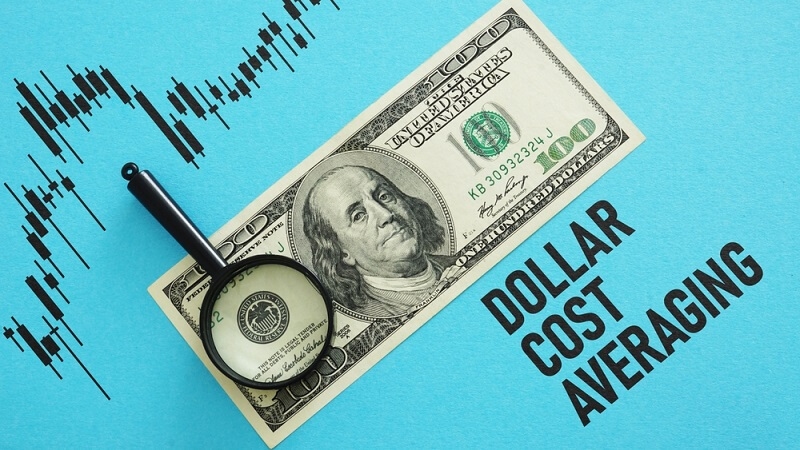
If you’re new to investing, you’re probably wondering how to begin without exposing too much cash at once. Should you immediately put all your money in the market or wait and invest over time? What happens if you invest a lump sum and the market crashes immediately? These are perfectly fair and valid concerns, and a strategy has been developed for people like you: Dollar Cost Averaging (DCA).
This article will introduce the dollar cost averaging strategy, a beginner’s guide to understanding how this relatively simple investment strategy works. We’ll discuss how DCA works in stock investing, how it compares to lump sum investing, and how it systematically reduces risk over time. DCA is generally one of the most intelligent investment strategies for beginner investors.
Dollar Cost Averaging (DCA) is an investment strategy that involves investing a fixed amount of money at regular intervals, regardless of what the market does. Rather than trying to time the market and investing a lump sum all at once, you take that investment, break it into smaller pieces, and invest it regularly.
For example:
In this example, you would buy shares at a lower cost when the price is lower and buy fewer shares when the cost is higher. This is a way of averaging the cost of buying into an investment.
The stock market fluctuates—that's just how investing works. It's common for new investors to feel nervous about market fluctuations. What if I invest everything and the market drops the next day?
That's the beauty of DCA. It's meant to:
Investing steadily reduces risk by dollar cost averaging and grows your discipline and emotion-free process for building wealth.

Let’s use a simple example to show how dollar cost averaging works in practice.
| Month | Stock Price | Shares Bought |
| 1 | $50 | 4.00 |
| 2 | $40 | 5.00 |
| 3 | $25 | 8.00 |
| 4 | $30 | 6.67 |
| 5 | $50 | 4.00 |
| Total | — | 27.67 shares |
You invested $1,000 and bought 27.67 shares.
So your average cost per share is $1,000 / 27.67 = ~$36.14/share
This average is lower than the highest price and better than buying all at once when the stock was $50. That’s the power of dollar cost averaging in action.
One of the most common comparisons in investing is DCA vs lump sum investing. Which one is better?
There’s no one-size-fits-all answer. Lump-sum investing might statistically outperform in rising markets, but DCA provides a safety net for beginners, especially those worried about volatility or unsure about market timing.
DCA is better if your primary goal is building a habit and reducing emotional investment.
If you're new to investing, here's how to apply DCA in real life:
This makes DCA one of the best beginner investment tactics—simple, steady, and scalable.
Risk is part of any investment, but DCA is uniquely suited to lower your exposure to timing risk.
Here’s how it helps:
DCA doesn’t eliminate risk—it’s not magic. But it smooths the ride, especially for those just starting.
Let’s get real—DCA is not a get-rich-quick strategy. It’s a steady, disciplined way to grow wealth. Here’s what to expect:
Still, DCA is an innovative and practical approach for many beginners because it offers peace of mind and reduced risk.
Just because DCA is simple doesn’t mean you can’t make mistakes. Here are a few to watch for:
This is when DCA is most effective. Don't panic—keep going.
Stick with diversified, long-term investments—not risky or speculative stocks.
You're defeating the purpose if you constantly pause or skip months because of the news. Trust the strategy.
If your platform charges high transaction fees, your returns can be affected. Use low-cost platforms or funds.
DCA is ideal for:
It’s also great for anyone who wants to automate investing without overthinking every decision.
Even seasoned investors sometimes use DCA when entering a volatile market because experts don’t know where prices will go next.
Let’s say you want to invest $5,000 but are nervous about doing it all at once.
Here’s a sample plan:
You’re still investing the full $5,000, but now you’re protected from sudden market shifts and developing a consistent investing routine.
Over the years, this approach can compound into serious wealth without requiring a crystal ball or nerves of steel.
You don't need to be an investing guru to be a savvy investor. Sometimes the simplest strategies are the most effective. For example, the dollar cost averaging investment strategy is among the most entry-level strategies available. It is easy to understand, use, and build to reduce stress as you invest and reduce your risk. Once you've learned how dollar cost averaging is applied in stock investing, the differences between dollar cost averaging and lump sum investing, and what you need to avoid when dollar cost averaging, you should feel comfortable starting to invest and build your wealth, even if you are investing a small amount.
So, the next time someone says investing is too risky or complicated, you can think—yeah, right! It takes consistency, patience, and the quiet strength of dollar cost averaging.
This content was created by AI